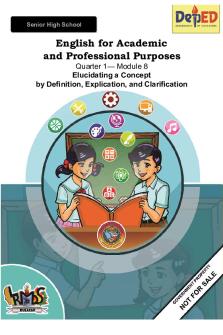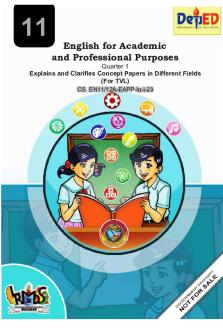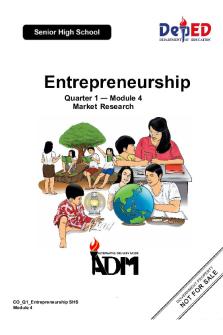Physical-Science 11 Q1 Module 11 How-Energy-is-Produced-and-Managed-08082020 PDF

| Title | Physical-Science 11 Q1 Module 11 How-Energy-is-Produced-and-Managed-08082020 |
|---|---|
| Author | Loraine Borja |
| Course | physics |
| Institution | Harris Memorial College |
| Pages | 30 |
| File Size | 1.6 MB |
| File Type | |
| Total Downloads | 76 |
| Total Views | 157 |
Summary
This is for the students in Physics. This will guide you from your modules. This have a complete lecture for you to understand the chemical chemistry....
Description
Physical Science Quarter 1 – Module 11: How Energy is Produced and Managed
Physical Science Alternative Delivery Mode Quarter 1 – Module 11: How Energy is Produced and Managed First Edition 2020 Republic Act 8293, Section 176 states that “no copyright shall subsist in any work of the Government of the Philippines. However, prior approval of the government agency or office wherein the work is created shall be necessary for exploitation of such work for profit. Such agency or office may, among other things, impose as a condition the payment of royalties. ” Borrowed materials (i.e., songs, stories, poems, pictures, photos, brand names, trademarks, etc.) included in this module are owned by their respective copyright holders. Every effort has been exerted to locate and seek permission to use these materials from their respective copyright owners. The publisher and authors do not represent nor claim ownership over them. Published by the Department of Education Secretary: Leonor Magtolis Briones Undersecretary: Diosdado M. San Antonio Development Team of the Module Writers: Amy B. Villar, Jennifer O. Tullao Editors: Robert G. Yumul Felipa A. Morada Reviewers: Ramonito O. Elumbaring, Angelica J. Macaraeg Felipa A. Morada Illustrator: Francis Victor A. Medrano Layout Artist: Mary Grace L. Asa, Pamela A. Lalusin Management Team: Wilfredo E. Cabral Job S. Zape Jr. Eugenio S. Adrao Elaine T. Balaogan Susan DL. Oribiana Lorna R. Medrano Edita T. Olan
Printed in the Philippines by ________________________ Department of Education – RegionIV-A CALABARZON Office Address: Telefax: E-mail Address:
Gate 2 Karangalan Village,Barangay San Isidro Cainta, Rizal 1800 02-8682-5773/8684-4914/8647-7487 [email protected]
Physical Science Quarter 1 – Module 11: How Energy is Produced and Managed
Introductory Message For the facilitator: Welcome to the Physical Science 11 Alternative Delivery Mode (ADM) Module on How Energy is Produced and Managed! This module was collaboratively designed, developed and reviewed by educators both from public and private institutions to assist you, the teacher or facilitator in helping the learners meet the standards set by the K to 12 Curriculum while overcoming their personal, social, and economic constraints in schooling. This learning resource hopes to engage the learners into guided and independent learning activities at their own pace and time. Furthermore, this also aims to help learners acquire the needed 21st century skills while taking into consideration their needs and circumstances. In addition to the material in the main text, you will also see this box in the body of the module:
Notes to the Teacher This contains helpful tips or strategies that will help you in guiding the learners.
As a facilitator you are expected to orient the learners on how to use this module. You also need to keep track of the learners' progress while allowing them to manage their own learning. Furthermore, you are expected to encourage and assist the learners as they do the tasks included in the module.
ii
For the learner: Welcome to the Physical Science 11 Alternative Delivery Mode (ADM) Module on How Energy is Produced and Managed! The hand is one of the most symbolized part of the human body. It is often used to depict skill, action and purpose. Through our hands we may learn, create and accomplish. Hence, the hand in this learning resource signifies that you as a learner is capable and empowered to successfully achieve the relevant competencies and skills at your own pace and time. Your academic success lies in your own hands! This module was designed to provide you with fun and meaningful opportunities for guided and independent learning at your own pace and time. You will be enabled to process the contents of the learning resource while being an active learner. This module has the following parts and corresponding icons: What I Need to Know
This will give you an idea of the skills or competencies you are expected to learn in the module.
What I Know
This part includes an activity that aims to check what you already know about the lesson to take. If you get all the answers correct (100%), you may decide to skip this module.
What’s In
This is a brief drill or review to help you link the current lesson with the previous one.
What’s New
In this portion, the new lesson will be introduced to you in various ways such as a story, a song, a poem, a problem opener, an activity or a situation.
What is It
This section provides a brief discussion of the lesson. This aims to help you discover and understand new concepts and skills.
What’s More
This comprises activities for independent practice to solidify your understanding and skills of the topic. You may check the answers to the exercises using the Answer Key at the end of the module.
What I Have Learned
This includes questions or blank sentence/paragraph to be filled in to process what you learned from the lesson.
What I Can Do
This section provides an activity which will help you transfer your new knowledge or skill into real life situations or concerns.
iii
Assessment
This is a task which aims to evaluate your level of mastery in achieving the learning competency.
Additional Activities
In this portion, another activity will be given to you to enrich your knowledge or skill of the lesson learned. This also tends retention of learned concepts.
Answer Key
This contains answers to all activities in the module.
At the end of this module you will also find:
References
This is a list of all sources used in developing this module.
The following are some reminders in using this module: 1. Use the module with care. Do not put unnecessary mark/s on any part of the module. Use a separate sheet of paper in answering the exercises. 2. Don’t forget to answer What I Know before moving on to the other activities included in the module. 3. Read the instruction carefully before doing each task. 4. Observe honesty and integrity in doing the tasks and checking your answers. 5. Finish the task at hand before proceeding to the next. 6. Return this module to your teacher/facilitator once you are through with it. If you encounter any difficulty in answering the tasks in this module, do not hesitate to consult your teacher or facilitator. Always bear in mind that you are not alone. We hope that through this material, you will experience meaningful learning and gain deep understanding of the relevant competencies. You can do it!
iv
What I Need to Know
This module was designed and written with you in mind. It is here to help you master how energy is harnessed from different sources: fossil fuels, biogas, geothermal, hydrothermal, batteries, solar cells, and biomass. The scope of this module permits it to be used in many different learning situations. The language used recognizes the diverse vocabulary level of students. The lessons are arranged to follow the standard sequence of the course. But the order in which you read them can be changed to correspond with the textbook you are now using. This module contains discussion about the different sources of energy, how they are generated and managed. After going through this module, you are expected to: 1. describe the different sources of energy; 2. give a brief summary of how energy is produced from different sources; 3. differentiate between renewable and non-renewable sources of energy; and 4. outline the pros and cons of the different sources of energy.
1
What I Know Multiple Choice. Read and analyze the given statements below. Write the chosen letter on a separate sheet of paper. 1. Which of the following is being described by this phrase, “It can be converted in form, but not created nor destroyed.” a. atom b. energy c. force d. matter 2. Energy that comes from sources that will run out or will not be replenished in our lifetimes —or even in many, many lifetimes. a. kinetic b. non-renewable c. potential d. renewable 3. It refers to the organic matter from plants and animals (microorganisms). a. battery b. biomass c. geothermal d. wind power 4. This form of energy includes hydrocarbons such as coal, oil, and natural gas that comes from organic remains of prehistoric organisms. a. batteries b. fossil fuels c. natural gas d. solar power 5. This source of energy is also known as “The People’s Power” referring to the easy deployment of solar panels and the introduction of “community solar gardens” where energy is shared among owners. a. biofuel b. geothermal c. hydroelectric d. solar energy
2
6. This renewable energy utilizes moving water to turn turbines. a. biomass b. geothermal c. hydroelectric d. solar wind 7. This source of energy is less of an environmental hazard compared to fossil fuels. a. batteries b. biomass c. geothermal d. hydrothermal 8. The energy that comes from fossil fuels came from the sun through this process when the prehistoric plants were still alive. a. cytokinesis b. meiosis c. mitosis d. photosynthesis 9. Which of the following converts the kinetic energy of falling water into mechanical energy? a. generator b. steam c. turbine d. wind 10. Below are the operational geothermal power plants in the Philippines EXCEPT a. Balugbug b. Malibara c. Malikban d. Tiwi 11. Wind turbines are installed in strategic locations to harness what type of energy from wind? a. chemical b. kinetic c. mechanical d. potential
3
12. Which of the following operational solar power plants is found in Batangas? a. Cavite Economic Zone Solar Power Project b. Central Mall Biňan Solar Power Plant c. CW Home Depot Solar Power Project d. Lian Sola Power Project 13. Which of the following is used to create methane and alcohol which are fuels useful in energy production and in powering automobiles? a. biomass b. carbon c. coal d. oil 14. Which is an advantage of solar energy? a. abundant b. amount of space c. expensive d. rare metals 15. Which country has many potential sites where solar energy may be harnessed because of its location in the globe? a. Australia b. Philippines c. Saudi Arabia d. United Kingdom
4
Lesson
1
How is Energy Produced and Managed
Energy is defined as the ability to do work. When work is done, energy is transferred from one object to another. Energy exists from different forms such as electrical and chemical energy. Most forms of energy can be classified as kinetic energy and potential energy. Kinetic energy is the energy of moving matter. Things with kinetic energy can do work. Kinetic energy depends on the object’s mass and velocity. Potential energy is the energy stored in an object because of its position or shape.
What’s In
Activity 1.1 Word Pool Direction: To get started, you have to choose the terms related to energy from the WORD POOL below. List down these words on the table on and write what you know about it on a separate sheet of paper. potential
nutrition
stomach
electricity
geothermal
atom
rock
solar
typhoon
renewable
battery
volcano
biomass
redshift
respiration
Term
What I know about it?
5
Notes to the Teacher Ask learners to name the different sources of energy and list examples on a separate sheet of paper.
What’s New
Activity 1.2 The diagram shows the different sources of energy in the Philippines and the percentages of each source. Analyze the different sources of energy from the different regions in the Philippines based on Figure 1 Gross Power Generation by Fuel 2013. Then, answer the questions that follow.
Figure1. Gross Power Generation by Fuel (2013), Retrieved July 17, 2020, http:// www.eia.gov/todayinenergy/images/2015.03.06/chart2.png).
6
Guide Questions: 1. What are the different sources of electricity in the Philippines? 2. Refer to the diagram above to complete the table below. Luzon Main source electricity
Visayas
Mindanao
of
Percentage Second Source of Electricity Percentage Third Source Electricity
of
Percentage
3. Based on the diagram, what can you say about the sources of energy from the different regions in the Philippines?
What is It
A power plant is an industrial facility that generates electricity from primary energy. Most power plants use one or more generators that convert mechanical energy into electrical energy in order to supply power to the electrical grid for society's electrical needs. The exception is solar power plants, which use photovoltaic cells (instead of a turbine) to generate this electricity. The type of primary fuel or primary energy flow that provides a power plant its primary energy varies. The most common fuels are coal, natural gas, and uranium (nuclear power). A substantially used primary energy flow for electricity generation is hydroelectricity (water). Other flows that are used to generate electricity include wind, solar, geothermal and tidal. Electrical sources can be broken down to two major groups: renewable and non-renewable sources. Renewable source is produced from sources that do not deplete or can be replenished within a human's life time. The most common examples include wind, solar, geothermal, biomass, and hydropower. This is in contrast to non-renewable source which is a natural resource that cannot be
7
readily replaced by natural means at a quick enough pace to keep up with consumption
I. Renewable Sources 1. Geothermal
Geothermal power utilizes the heat energy from the earth’s crust. This heat energy heats up rocks which, in turn, heats up nearby groundwater. The Malitbog Geothermal Power Station is a 232.5 MW geothermal power plant or an earth steam turbined electric generator--the world's largest geothermal power plant under one roof located in Malitbog, Kananga, Leyte, Philippines. The power plant is one of four operating in the Leyte Geothermal Production Field. Geothermal energy is produced by the heat of Earth's molten interior. This energy is harnessed to generate electricity when water is injected deep underground and returns as steam (or hot water, which is later converted to steam) to drive a turbine on an electric power generator that produces electricity. Geothermal energy is less of an environmental hazard compared to fossil fuels though it still has some emissions of carbon dioxide, nitrous oxide, and sulfur dioxide.
8
Some
of the operational geothermal plants in the Philippines
power are: • • • • • •
Malibarara Geothermal Power Plant in Sto. Tomas, Batangas Makban Geothermal Power Plant and Makban Binary Geothermal Power Plant in Bay, Laguna Tiwi Geothermal Power Plant in Tiwi, Albay Bacon Manito Geothermal Power Plant in Sorosogon Unified Leyte Geothermal Power Plant Tongonan Geothermal Power Plant in Leyte Southern Negros Geothermal Production Field – Nasulo Geothermal Power Plant and Palinpinon Geothermal Power Plant in Valencia Negros Occidental
2. Hydroelectric Hydroelectric power (hydropower) is derived from the energy of falling or moving water to generate electricity. Among other purposes, water is widely used to produce electricity. Hydropower is a proven, mature, predictable, and price competitive technology. A number of on- and off-grid hydropower plants have been built throughout the country, including impounding dams and run-of-river types. Impounding dams are able to supply energy during peak and off-peak hours while run-of-river types supply electricity whenever capable, depending on the volume of water that is discharged from the watersheds. A turbine converts the kinetic energy of falling water into mechanical energy. Then a generator converts the mechanical energy from the turbine into electrical energy. The generator power is stepped up to a higher voltage from the substation, and then exported for transmission.
9
Some of the operational hydroelectric power plants in the Philippines are: • • •
Palakpakin Hydroelectric Power Plant in San Pablo, Laguna Balugbog Hydroelectric Power Plant in Narcarlan, Laguna Cantingas Hydroelectric Power Plant in San Fernando, Romblon
3. Wind power While an electric fan uses electricity to produce wind, a wind turbine uses wind to produce electricity. A wind turbine can generate megawatts of power, depending on the weather conditions. In fact, an indicator for a potential wind farm site is the presence of flagging trees or trees that are bent like how a flag would look like due to strong winds. Because of the vast land area a wind farm occupies, unused areas can be co-located with agricultural crops or even a solar farm. Wind has been used in centuries to move ships and pump water. Wind turbines are installed in strategic locations to harness the mechanical energy from wind. Some of the most recent developments are the Bangui Wind Farm, Burgos Wind Farm, and Caparispisan Wind Farm in Ilocos Norte, the Wind Energy Power System in Oriental Mindoro, San Lorenzo Wind Farm in Guimaras, Nabas Wind Farm in Aklan and Pililla Wind Farm in Rizal.
10
4. Solar Cells If plants photosynthesize using sunlight, electric-powered technologies can also use sunlight for energy. Solar power is a variable energy source that is dependent on the cycle of the sun. The Philippines, being situated near the equator, has many potential sites where solar energy may be harnessed. With recent technology, solar power systems can be both applied to on- and off-grid areas. Aggressive economic growth for the country is not far behind. As long as there is sunlight, solar power will always be available. Solar power technology may not generate energy at night but it is capable of supplying electricity to the grid at daytime. A solar cell, or photovoltaic cell, is an electrical device that converts the energy of light directly into electricity by the photovoltaic effect, which is a physical and chemical phenomenon. It is a form of photoelectric cell, defined as a device whose electrical characteristics, such as current, voltage, or resistance, vary when exposed to light. Individual solar cell devices are often the electrical building blocks of photovoltaic modules, known colloquially as solar panels.
11
Some of the operational solar power plants in the Philippines are: • • •
Lian Sola Power Project and Calatagan Solar Power Project in Ca latagan, Batangas Cavite Economic Zone Solar Power Project in Rosario and General Trias, Cavite CW Home Depot Solar Power Project and Central Mall Binan Solar Power Plant in Biñan City, Laguna
Solar energy is also known as “The People’s Power,” referring to the easy deployment of solar panels and the introduction of “community solar gardens” where energy is shared among owners. •
Solar energy is abundant, requires low maintenance, and is environmentallyfriendly.
•
Emissions associated with the manufacture of solar panels are present but very minimal compared to pollution caused by burning fossil fuels.
•
Two of the harmful emissions from the manufacture of solar panels are nitrogen trifluoride and sulfur hexafluoride.
•
Both are potent greenhouse gases.
•
Some disadvantages of solar energy are: it is expensive, requires rare metals, and requires a good amount of space. Thankfully, the technology is continuously improving.
...
Similar Free PDFs

Final EAPP Q1 Module 8 - EAPP 11
- 30 Pages

Final EAPP Q1 Module 10 - EAPP 11
- 24 Pages

Final EAPP Q1 Module 9 - EAPP 11
- 22 Pages

Partizipation + Medien Q1 11
- 1 Pages
Popular Institutions
- Tinajero National High School - Annex
- Politeknik Caltex Riau
- Yokohama City University
- SGT University
- University of Al-Qadisiyah
- Divine Word College of Vigan
- Techniek College Rotterdam
- Universidade de Santiago
- Universiti Teknologi MARA Cawangan Johor Kampus Pasir Gudang
- Poltekkes Kemenkes Yogyakarta
- Baguio City National High School
- Colegio san marcos
- preparatoria uno
- Centro de Bachillerato Tecnológico Industrial y de Servicios No. 107
- Dalian Maritime University
- Quang Trung Secondary School
- Colegio Tecnológico en Informática
- Corporación Regional de Educación Superior
- Grupo CEDVA
- Dar Al Uloom University
- Centro de Estudios Preuniversitarios de la Universidad Nacional de Ingeniería
- 上智大学
- Aakash International School, Nuna Majara
- San Felipe Neri Catholic School
- Kang Chiao International School - New Taipei City
- Misamis Occidental National High School
- Institución Educativa Escuela Normal Juan Ladrilleros
- Kolehiyo ng Pantukan
- Batanes State College
- Instituto Continental
- Sekolah Menengah Kejuruan Kesehatan Kaltara (Tarakan)
- Colegio de La Inmaculada Concepcion - Cebu











